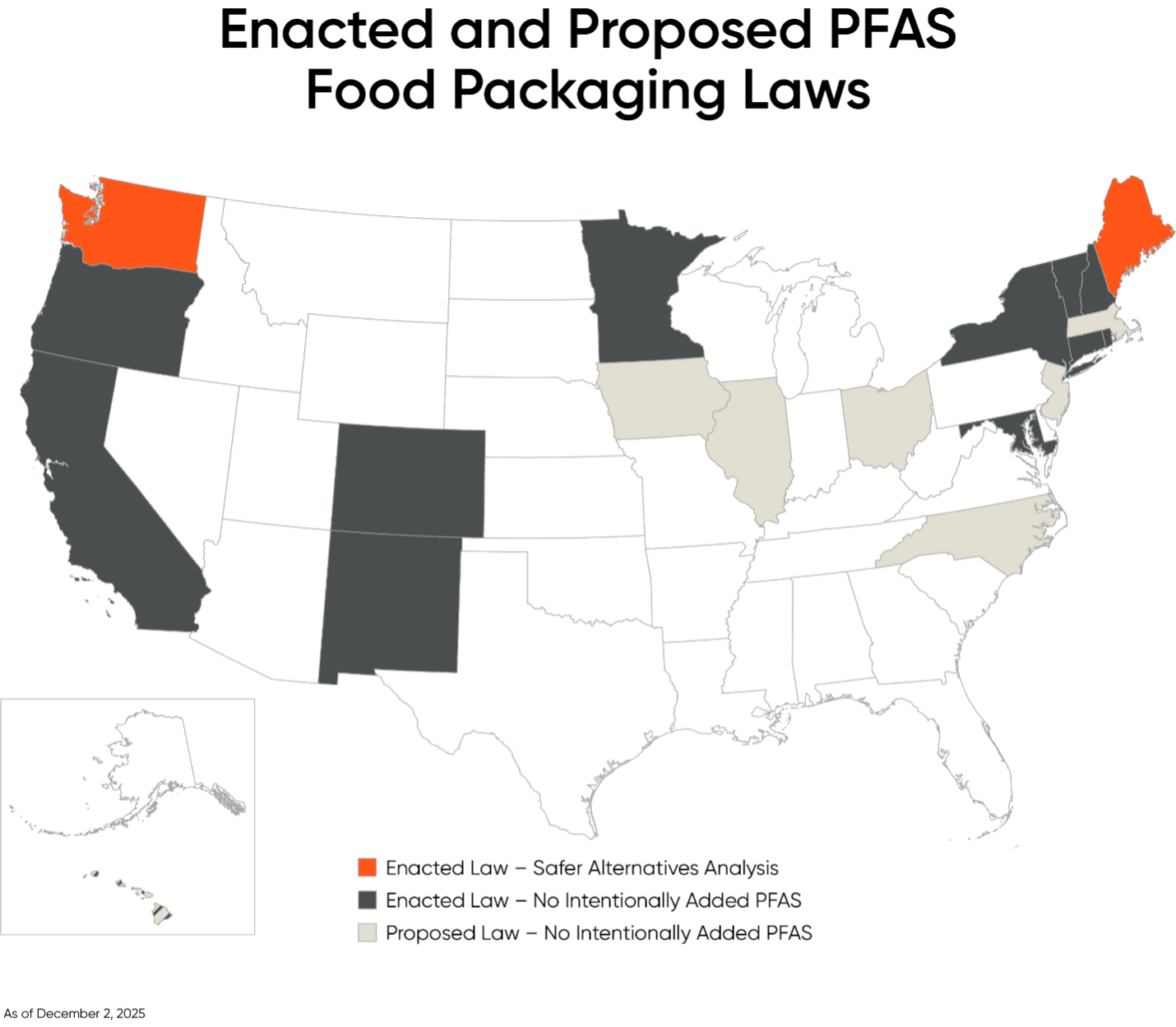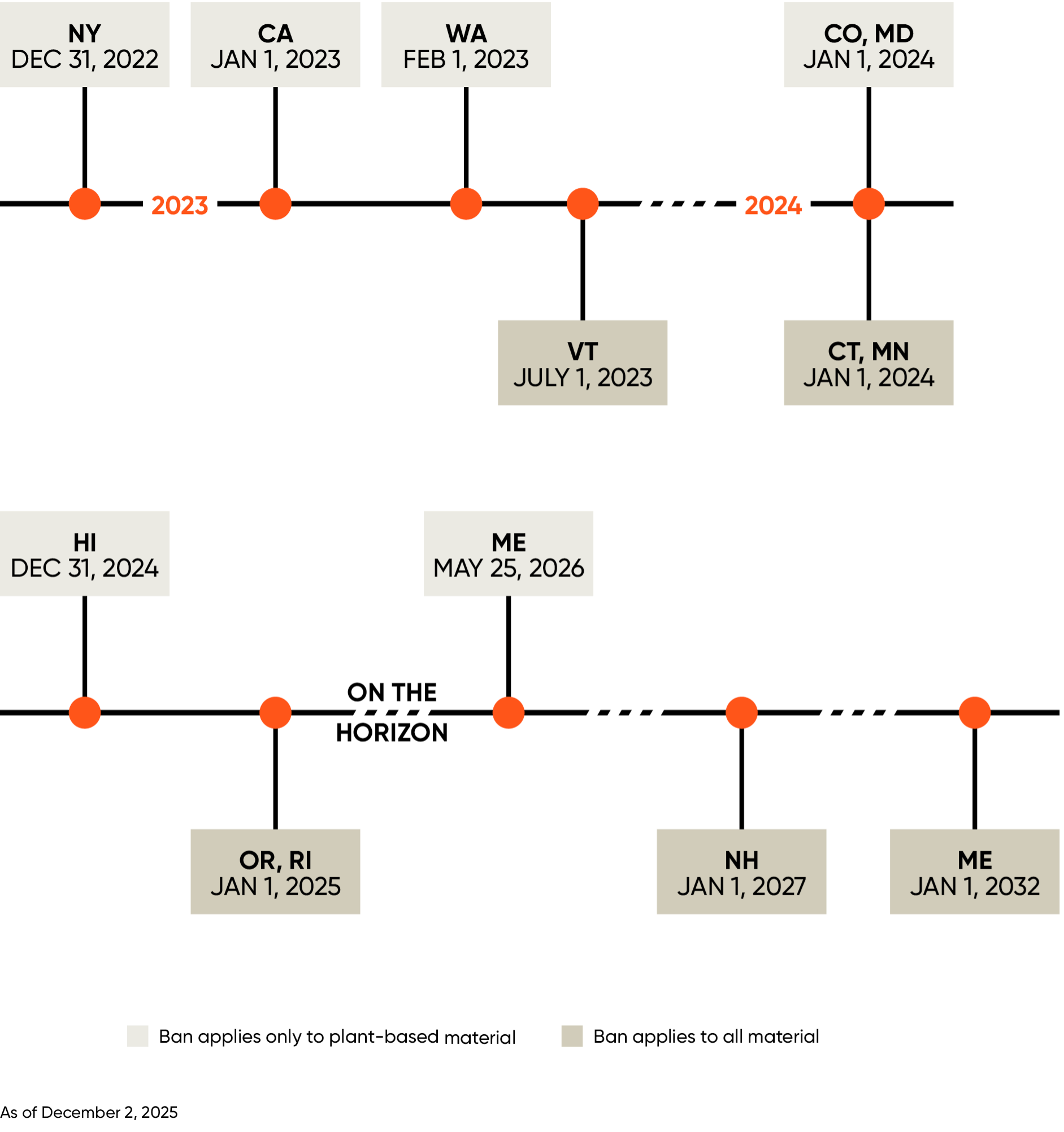Insights
PFAS in food packaging: state-by-state regulations
Updated: December 2025
Dec 19, 2025Summary
Certain states around the U.S. are dishing out their own laws seeking to regulate the presence or use of PFAS in food packaging. Thus far, and while there is limited federal legislation addressing these chemicals in food packaging, 14 (fourteen) states have enacted laws related to PFAS substances in food containers and packaging materials (“Food Packaging”). There are an additional 10 (ten) proposed bills currently pending in various states. According to the United States Environmental Protection Agency (“EPA”), commonly cited examples of Food Packaging that have historically contained PFAS substances include “grease-resistant paper, fast food containers/wrappers, microwave popcorn bags, pizza boxes, and candy wrappers.”
Federal Actions
Grease-Proofing Substances
In February of 2024, the Food and Drug Administration (“FDA”) announced that grease-proofing substances containing PFAS materials are “no longer being sold by manufacturers for food contact use in the U.S. market.” The shift was not the result of a formal ban or restriction on the use of PFAS in food contact surfaces; instead, in 2020, FDA began a voluntary phase out of PFAS substances with Food Packaging manufacturers.
In January of 2025, the FDA published in the Federal Register that the 35 food contact notifications (“FCNs”) related to PFAS-containing food contact substances are “no longer effective.” EPA further explained that “the uses of these 35 FCNs have been abandoned because the manufacturers or suppliers have ceased production, supply, or use of the food contact substances. The 35 FCNs had previously authorized food contact substances used for grease-proofing coatings applied to paper and paperboard packaging to prevent leaking of oil and water.” The deadline for use of any existing inventory was June 30, 2025.
FDA also published a summary document discussing the actions the agency has taken to eliminate the presence of PFAS substances in grease-proofing materials. FDA additionally published a document entitled “Authorized Uses of PFAS in Food Contact Applications,” as well as a question and answer document, including a discussion about how the FDA is addressing PFAS in foods.
Proposed Federal Legislation
On April 30, 2025, Mike Lawler (R-NY) and other legislators introduced a bill titled the PFAS-Free Procurement Act, which, among other things, would prohibit federal agencies from entering into contracts for numerous products containing PFOS or PFOA, including for nonstick cookware and cooking utensils. The bill has been referred to a committee, and it is unclear whether the bill will pass and be signed into law, but the bill indicates the possibility of federal action on this issue.
State Food Packaging Laws
Against this federal backdrop, state legislatures have enacted a variety of different laws further addressing the use of PFAS in Food Packaging. The state regulatory approaches fall generally into two main categories: first, some states have adopted a PFAS “alternatives” framework; and second, others have imposed a prohibition on “intentionally added” PFAS.
Under the PFAS alternatives framework, an organization or state agency typically conducts an analysis to determine if a viable option is commercially available both in sufficient quantity and at a comparable cost for various Food Packaging items containing intentionally added PFAS. Usually, the alternative must perform as well as or better than the specific Food Package containing PFAS.
States have taken an inconsistent approach to the scope of Food Packaging that is subject to the laws requiring alternatives. Some states have limited the definition to plant or fiber-based Food Packaging, while other states have included all Food Packaging. The one constant in the variety of regulatory approaches seems to be the broad definition of PFAS, which is universally defined as “fluorinated organic chemicals containing at least one fully fluorinated carbon atom.”
This map and the following information below provide a more detailed analysis of each state’s regulatory approach and is current as of December 2, 2025. This area of law is constantly changing as demonstrated by the number of bills that are currently being proposed.

Enacted Law - no intentionally added PFAS |
|
Effective date
January 1, 2023
Food Packaging Description
No person shall distribute or sell any food packaging that either has:
- PFAS that are intentionally added to a product and that has a functional or technical effect in the product; or
- More than 100 ppm of PFAS substances as measured in total organic fluorine.
“Food packaging” is defined as “a nondurable package, packaging component, or food service ware that is intended to contain, serve, store, handle, protect, or market food, foodstuffs, or beverages, and is comprised, in substantial part, of paper, paperboard, or other materials originally derived from plant fibers.”
Packaging Distinction
Plant-based food packaging
Regulatory Status
Enacted
Details
Enforcement Letter for AB 1200
Effective date
January 1, 2024
Food Packaging Description
No person shall sell or distribute any product in the Food packaging category if the product contains intentionally added PFAS substances.
"Food packaging" is defined as “a package or packaging component used in direct contact with food and that is composed, in substantial part, of paper, paperboard, or other materials originally derived from plant fibers.”
"Intentionally added PFAS chemicals" means PFAS chemicals that a manufacturer has intentionally added to a product and that have a functional or technical effect on the product.
"Intentionally added PFAS chemicals" includes PFAS chemicals that are intentional breakdown products of an added chemical.
Packaging Distinction
Plant-based food packaging
Regulatory Status
Enacted
Details
Effective date
January 1, 2024
Food Packaging Description
No Food package to which PFAS substances are intentionally introduced in any amount during manufacturing or distribution shall be offered for sale or for promotional purposes by its manufacturer or distributor.
"Food packaging" is defined as “any package or packaging component that is applied to or in direct contact with any food or beverage.”
"Intentionally introduced" means deliberately utilized PFAS in the formulation of a package or packaging component where the continued presence PFAS is desired in the final package or packaging component to provide a specific characteristic, appearance or quality. The use of post-consumer recycled materials as feedstock for the manufacture of new packaging materials where some portion of the recycled materials may contain amounts of PFAS shall not usually be considered intentional introduction.
Packaging Distinction
All food packaging
Regulatory Status
Enacted
Details
Effective date
December 31, 2024
Food Packaging Description
It is unlawful to manufacture, sell, or distribute certain Food packaging (specifically wraps and liners, plates, food boats, and pizza boxes) to which PFAS chemicals have been intentionally introduced in any amount.
"Food packaging" is defined as “a package or packaging component that is applied to or in direct contact with any food or beverage and is comprised, in substantial part, of paper, paperboard, or other materials originally derived from plant fibers.”
"Intentionally introduced" means deliberately utilized PFAS chemicals in the formulation of a package or packaging component where the continued presence of the PFAS is desired in the final package or packaging component to provide a specific characteristic, appearance, or quality.
Packaging Distinction
Plant-based food packaging
Regulatory Status
Enacted
Details
Effective date
January 1, 2024
Food Packaging Description
A manufacturer or distributor may not manufacture, distribute, or sell a Food package to which PFAS substances have been intentionally added.
“Food package” is defined as “a package that is designed and intended for direct food contact and is composed, in substantial part, of paper, paperboard, or other materials originally derived from plant fibers, including: (1) a food or beverage product that is contained in a food package or to which a food package is applied; (2) a packaging component of a food package; and (3) plastic disposable gloves used in commercial or institutional food service.”
“Intentionally added” means the act of deliberately using a chemical in the formation of a product where the chemical’s continued presence is desired in the product to provide a specific characteristic.
Packaging Distinction
Plant-based food packaging
Regulatory Status
Enacted
Details
Effective date
January 1, 2024
Food Packaging Description
No person shall manufacture, sell, distribute, or offer for use a Food package that contains intentionally added PFAS.
"Food package" is defined as “a container applied to or providing a means to market, protect, handle, deliver, serve, contain, or store a food or beverage.”
Food package includes: (1) a unit package, an intermediate package, and a shipping container; (2) unsealed receptacles, such as carrying cases, crates, cups, plates, bowls, pails, rigid foil and other trays, wrappers and wrapping films, bags, and tubs; and (3) an individual assembled part of a food package, such as any interior or exterior blocking, bracing, cushioning, weatherproofing, exterior strapping, coatings, closures, inks, and labels.
"Intentionally added" means PFAS deliberately added during the manufacture of a product where the continued presence of PFAS is desired in the final package or packaging component to perform a specific function
Packaging Distinction
All food packaging
Regulatory Status
Enacted
Details
Effective date
January 1, 2027
Food Packaging Description
Food packaging and containers shall be prohibited from being sold, offered for sale, or distributed for sale or for promotional purposes.
“Food containers” are defined as containers applied to or providing a means to market, protect, handle, deliver, serve, contain, or store a food or beverage.
“Food packaging” includes: (1) a unit package, an intermediate package, and a shipping container; (2) unsealed receptacles, such as carrying cases, crates, cups, plates, bowls, pails, rigid foil and other trays, wrappers and wrapping films, bags, and tubs; and (3) an individual assembled part of a food package, such as any interior or exterior blocking, bracing, cushioning, weatherproofing, exterior strapping, coatings, closures, inks, and labels.
“Intentionally added PFAS” means PFAS that a manufacturer has intentionally added to a product or product component that has a functional or technical effect in the product or product component, including breakdown products that have a functional or technical effect in the product.
Packaging Distinction
All food packaging
Regulatory Status
Enacted
Details
Effective date
January 1, 2027
Food Packaging Description
A manufacturer shall not sell, offer, or distribute, directly or indirectly or through intermediaries, Food packaging if that product contains an intentionally added PFAS substance, subject to some exemptions.
"Food packaging" means a container, unit package, intermediate package, or shipping container applied to or providing a means to market, protect, handle, deliver, serve, contain or store a food or beverage, including an individual assembled part of a food package.
“Intentionally added" means a PFAS substance deliberately added or used during the manufacture of a product where the continued presence, at any level or concentration, is desired or expected in the final product or one of the product's components.
Packaging Distinction
All food packaging
Regulatory Status
Enacted
Details
Effective date
December 31, 2022
Food Packaging Description
No person shall distribute or sell food packaging containing PFAS substances as intentionally added chemicals.
"Food packaging" is defined as “a package or packaging component that is intended for direct food contact and is comprised, in substantial part, of paper, paperboard, or other materials originally derived from plant fibers.”
Packaging Distinction
Plant-based food packaging
Regulatory Status
Enacted
Details
New York Department of Environmental Conservation Information
Effective date
January 1, 2025
Food Packaging Description
A person may not sell or distribute a foodware container containing intentionally added PFAS substances.
“Foodware container” includes the following: bowls, plates, cups, lids, clamshells or other containers or any other items used for serving or containing prepared food, including takeout food and leftovers from partially consumed meals prepared by food vendors.
“Food vendor” is defined as “a business, organization or other person that sells prepared food or offers prepared food for sale to the public, including, but not limited to, a store, shop or other sales outlet, a restaurant, a delicatessen or a cart, truck or other vehicle from which the business, organization or other person sells prepared food or offers prepared food for sale.”
Packaging Distinction
All food packaging
Regulatory Status
Enacted
Details
Effective date
January 1, 2025
Food Packaging Description
No manufacturer or distributor shall sell a food package in which PFAS substances have been intentionally introduced in any amount.
"Food packaging" is defined as “any package or packaging component that is applied to or in direct contact with any food or beverage.”
Packaging Distinction
All food packaging
Regulatory Status
Enacted
Details
Effective date
July 1, 2023
Food Packaging Description
A manufacturer, supplier, or distributor shall not manufacture, sell, or distribute a food package to which PFAS substances have been intentionally added and are present in any amount.
“Food package” or “food packaging” means a package or packaging component that is intended for direct food contact.
“Package” is defined as “a container providing a means of marketing, protecting, or handling a product and shall include a unit package, an intermediate package, and a shipping container. Package also means unsealed receptacles, such as carrying cases, crates, cups, pails, rigid foil and other trays, wrappers and wrapping films, bags, and tubs.”
“Packaging component” is defined as “an individual assembled part of a package, such as any interior or exterior blocking, bracing, cushioning, weatherproofing, exterior strapping, coatings, closures, inks, and labels, and disposable gloves used in commercial or institutional food service.”
Packaging Distinction
All food packaging
Regulatory Status
Enacted
Details
Vermont Department of Health Information
Vermont Department of Health Guidance for Manufacturers, Suppliers, and Distributors
proposed Law - no intentionally added PFAS |
|
Effective date
January 1, 2028
Food Packaging Description
Beginning on January 1, 2028, a person shall not distribute, sell, or offer for sale a Food packaging product that contains intentionally added PFAS.
“Food packaging” means a package, packaging component, or food service ware that is intended to provide a means to market, protect, handle, deliver, serve, contain, or store a food or beverage, including but not limited to:
- A unit package, an intermediate package, or a shipping container;
- Unsealed receptacles, such as carrying cases, crates, cups, plates, bowls, pails, rigid foil and other trays, wrappers and wrapping films, bags, or tubs; and
- An individual assembled part of a food package, such as an interior or exterior blocking, bracing, cushioning, waterproofing or heat or cold protection, coating, closures, inks, or labels.
“Food packaging” does not include a product that meets the definition of “food packaging” in Section 109000 or a refrigerator or other appliance used in a home or commercial setting, such as a hospital.
“Intentionally added PFAS” means PFAS added to a product that has a functional or technical effect in the product, including the PFAS components of intentionally added chemical mixtures and PFAS that are intentional results or outcomes of an added chemical or process, such as PFAS created as a result of fluorination of plastic.
Packaging Distinction
All food packaging
Regulatory Status
Vetoed by Governor
Details
CA Health and Safety Code § 109000 (Definitions)
Effective date
December 31, 2026
Food Packaging Description
It shall be unlawful to manufacture, sell, or distribute any food packaging that contains intentionally added PFAS, subject to some exceptions.
The proposed law has no definition of food packaging, but it includes all kinds of food packaging (including food service ware) whereas the enacted law includes only certain types of food packaging.
Packaging Distinction
All food packaging
Regulatory Status
Proposed
Details
Effective date
January 1, 2026
Food Packaging Description
A person may not sell, offer, or distribute Food packaging if it contains intentionally added PFAS.
Beginning January 1, 2033, a person may not sell, offer, or distribute any product that contains intentionally added PFAS, unless the Board has determined that the use of the PFAS in the product is currently unavoidable.
"Food packaging" means a container applied to or providing a means to market, protect, handle, deliver, serve, contain, or store a food or beverage.
"Food packaging" includes:
- a unit package, an intermediate package, and a shipping container;
- unsealed receptacles, such as carrying cases, trays, wrappers and wrapping films, bags, and tubs; and
- an individually assembled part of a food package, such as any interior or exterior blocking, bracing, cushioning, weatherproofing, exterior strapping, coatings, closures, inks, and labels.
"Intentionally added" means PFAS deliberately added during the manufacture of a product or reasonably anticipated to be present.
Packaging Distinction
All Food Packaging
Regulatory Status
Proposed Law I
Details
Effective date
January 1, 2026
Food Packaging Description
A person may not sell, offer, or distribute Food packaging or food contact products if these products contain intentionally added PFAS.
"Food packaging" or "food contact product" means a container applied to or providing a means to market, protect, handle, deliver, serve, contain, or store a food or beverage.
"Food packaging" includes:
- a unit package, an intermediate package, and a shipping container;
- unsealed receptacles, such as carrying cases, trays, wrappers and wrapping films, bags, and tubs; and
- an individually assembled part of a food package, such as any interior or exterior blocking, bracing, cushioning, weatherproofing, exterior strapping, coatings, closures, inks, and labels.
"Intentionally added PFAS" means PFAS deliberately added during, or reasonably anticipated to be present in, the manufacture of a product or its final packaging.
Packaging Distinction
All Food Packaging
Regulatory Status
Proposed Law II
Details
Effective date
January 1, 2026
Food Packaging Description
A person shall not knowingly manufacture, sell, or distribute Food packaging to which a PFAS substance has been intentionally added in any amount.
This rule does not apply to new Food packaging that is sold, offered, or distributed for promotional purposes by a retailer or wholesaler on or after January 1, 2026, that was imported into the state or otherwise purchased or acquired by the retailer or wholesaler for sale or distribution prior to January 1, 2026.
Beginning on January 1, 2032, a person shall not sell, offer, or distribute any product that contains an intentionally added PFAS substance, unless the director has determined that the use of a PFAS substance in the product is a currently unavoidable use.
“Food packaging” means a package, including a unit package, intermediate package, or shipping container, or a packaging component, including any interior or exterior blocking, bracing, cushioning, weatherproofing, exterior strapping, coating, closure, ink, or label, that is intended for the marketing, protection, or handling of a product intended for food contact or used to store food for sale.
Packaging Distinction
All food packaging
Regulatory Status
Proposed
Details
Effective date
January 1, 2030
Food Packaging Description
No person or entity shall manufacture, sell, or distribute Food packaging to which PFAS substances have been intentionally added in any amount.
“Food package" is defined as “a package or packaging component that is intended for the marketing, protection or handling of a product intended for food contact or used to store food and foodstuffs for sale.”
“Intentionally added” PFAS that is added to a product, or enters the product from the manufacturing or processing of that product; the addition of which is known or reasonably ascertainable by the manufacturer.
“Intentionally added” PFAS also includes any degradation by-products of PFAS or the use of PFAS or PFAS precursors as a processing agent, mold release agent, or the creation of PFAS via chemical reactions.
Packaging Distinction
All food packaging
Regulatory Status
Proposed Bill I
Details
Effective date
January 1, 2027
Food Packaging Description
No person or entity shall manufacture, sell, or distribute Food packaging to which PFAS substances have been intentionally added in any amount.
“Food package" is defined as a package or packaging component that is intended for the marketing, protection, or handling of a product intended for food contact or used to store food for sale.
Packaging Distinction
All food packaging
Regulatory Status
Proposed Bill II
Details
Effective date
Two years after the effective date of the legislation
Food Packaging Description
No person shall sell or distribute any food packaging that contains an intentionally added PFAS substance unless it “contains a technically unavoidable trace quantity of PFAS, which stems from impurities of natural or synthetic ingredients or the manufacturing process, storage, or migration from packaging of the product.”
“Food Packaging” is defined as “a nondurable package, packaging component, or food service ware that is intended to contain, serve, store, handle, protect, or market food, foodstuffs, or beverages, and is composed, in substantial part, of paper, paperboard, or other materials originally derived from plant fibers.”
Food packaging includes the following: food or beverage containers, take-out food containers, unit product boxes, liners, wrappers, serving vessels, eating utensils, straws, food boxes, and disposable plates, bowls, or trays.
Packaging Distinction
Plant-based food packaging
Regulatory Status
Proposed
Details
Effective date
October 1, 2025
Food Packaging Description
No person may manufacture, sell, or offer for sale any covered product, including Food packaging, that contains intentionally added PFAS.
Food Packaging: A package, compostable container, or packaging component that is intended for direct food content.
Intentionally added PFAS: (1) PFAS added to a product or one of the product's components that have a function or technical effect in the product; or (2) PFAS used or produced during the manufacture or processing of a product, including any source of PFAS that is reasonably known to be present, such as using processing agents, mold release agents, or fluorination.
Packaging Distinction
All food packaging
Regulatory Status
Proposed Bill
Details
Effective date
January 1, 2027
Food Packaging Description
No manufacturer shall sell Food packaging if that product contains an intentionally added PFAS.
"Food packaging" means a container, unit package, intermediate package, or shipping container applied to or providing a means to market, protect, handle, deliver, serve, contain, or store a food or beverage, including an individually assembled part of a food package.
"Intentionally added" means a PFAS deliberately added or used during the manufacture of a product in which the continued presence, at any level or concentration, of the PFAS is desired or expected in the final product or one of the product's components.
Packaging Distinction
All food packaging
Regulatory Status
Proposed Bill
Details
Enacted Law - Safer Alternatives Analysis |
|
Effective date
January 1, 2026 (notification)
May 25, 2026 (food packaging)
January 1, 2032 (all products that contain intentionally added PFAS)
Food Packaging Description
Beginning on January 1, 2026, a manufacturer of a product that contains intentionally added PFAS shall submit a written notification to the Maine Department of Environmental Protection (“MDEP”).
Beginning on May 25, 2026, a manufacturer, supplier, or distributor may not offer for sale any food packaging intended for direct food contact comprised of materials derived from plant fibers to which PFAS have been intentionally introduced in any amount greater than an incidental presence.
Beginning on January 1, 2032, a person may not sell or distribute any product that contains intentionally added PFAS, unless MDEP has determined that the use of PFAS in the product is of unavoidable use.
Packaging Distinction
Plant-based Food Packaging (2026) and All Food Packaging (2032)
Regulatory Status
Enacted
Details
32 M.S.R.A. 26-A.1733 (Definitions)
32 M.S.R.A. 26-A.1733, LD 217 and LD 1537
Effective date
February 1, 2023
Food Packaging Description
No person may manufacture, sell, or distribute food packaging to which PFAS chemicals have been intentionally added in any amount. This prohibition may not take effect until the Department of Ecology (“DOE”) identifies that safer alternatives are available.
"Food package" is defined as “a package or packaging component that is intended for direct food contact and is comprised, in substantial part, of paper, paperboard, or other materials originally derived from plant fibers.”
"Safer alternative" is defined as “an alternative substance or chemical, demonstrated by an alternatives assessment, that meets improved hazard and exposure considerations and can be practicably and economically substituted for the original chemical.”
DOE published a first report, dated February 2021, specifically stating that: (1) six chemical alternatives were less hazardous than PFAS; (2) one chemical alternative was more hazardous than PFAS; and (3) the data was insufficient to evaluate three chemical alternatives.
DOE published a second report, dated May 2022, that identified numerous alternatives for PFAS substances in the following five categories of food packaging: 1) bags and sleeves; 2) bowls; 3) flat serviceware; 4) open-top containers; and 5) closed containers.
According to DOE, food packaging manufacturers, distributors, and retailers may not manufacture, sell, or distribute:
(1) Wraps, plates, food boats, or pizza boxes with PFAS chemicals intentionally added as of February 1, 2023; and
(2) Bags, sleeves, bowls, flat serviceware (plates and trays), open-top containers (french fry cartons and food cups), or closed containers (clamshells) with PFAS chemicals intentionally added as of May 1, 2024.
Packaging Distinction
Plant-based food packaging
Regulatory Status
Enacted
Details
Safer Alternatives Analysis Report in Food Packaging (DOE Report I)
Safer Alternatives to PFAS in Food Packaging (DOE Report II)
No PFAS Food Packaging regulations (as of the date of publication): Alabama, Alaska, Arizona, Arkansas, Delaware, Florida, Georgia, Idaho, Indiana, Illinois, Iowa, Kansas, Kentucky, Louisiana, Massachusetts, Michigan, Mississippi, Missouri, Montana, Nebraska, Nevada, New Jersey, North Carolina, North Dakota, Ohio, Oklahoma, Pennsylvania, South Carolina, South Dakota, Tennessee, Texas, Utah, Virginia, West Virginia, Wisconsin, and Wyoming.
Timing
With respect to the enacted state laws, the legislation imposes different deadlines for compliance. Some requirements have already become effective, and others will go into effect in the future. The following timeline visually demonstrates the compliance schedule across the various states where legislation is in place.

- New York - December 31, 2022 (ban applies only to plant based material)
- California - January 1, 2023 (ban applies only to plant based material)
- Washington - February 1, 2023 (ban applies only to plant based material)
- Vermont -July 1, 2023 (ban applies to all materials)
- Colorado and Maryland - January 1, 2024 (ban applies only to plant based material)
- Connecticut and Minnesota - January 1, 2024 (ban applies to all materials)
- Hawaii - December 31, 2024 (ban applies only to plant based material)
- Oregon and Rhode Island - January 1, 2025 (ban applies to all materials)
On the horizon
- Maine - May 25, 2026 (ban applies only to plant based material)
- New Hampshire - January 1, 2027 (ban applies to all materials)
- Maine - January 1, 2032 (ban applies to all materials)
Compliance Steps and Risk Mitigation for Businesses
The following are some initial steps that businesses can take to evaluate and mitigate potential regulatory risk based on a company’s manufacturing, distribution, or sale of Food Packaging. The unsurprising first step is to determine if your business manufactures, distributes, or sells any Food Packaging products containing intentionally added PFAS materials. That question can be more difficult to answer than it initially appears, so here are a few fundamental questions to consider when investigating:
If you manufacture Food Packaging, do you intentionally add or introduce PFAS substances in any amount?
- Importantly, “intentionally added or introduced” often means into the finished product or into the process to manufacture the product.
- Answering this question may require discussions with raw materials vendors, and an examination of your manufacturing process and process equipment, including potential for the presence of PFAS in process water if any is used as part of your operations.
Does your business sell, distribute, offer for sale, or use Food Packaging materials to which PFAS substances have been intentionally added?
- Once again, the answer to this question will likely rely on discussions with your suppliers and vendors.
- Companies should also review their purchase agreements and contracts with suppliers and customers to understand who is liable if non-compliant products are later sold, or if there is a change in information previously shared through the supply chain.
- Note that in California an additional threshold is whether your Food Packaging contains more than 100 ppm of Total Organic Fluorine, regardless of whether any PFAS was intentionally added.
If any of the Food Packaging that you either manufacture or source contains intentionally added PFAS, the next step is to evaluate how and when reformulation might be possible. In addition, any replacement chemistry should be evaluated to determine whether it is in fact an appropriate alternative to the PFAS chemistry under applicable state laws.
Additional Considerations
This insight does not document the legislation regarding the recyclability of food or beverage packaging because these laws do not exclusively involve PFAS substances. This insight also does not address developments in Extended Producer Liability (“EPR”) or polytetrafluoroethylene (“PTFE”), but some EPR policy initiatives may address PFAS and certain PTFE products may contain PFAS substances.
Moreover, this insight does not address general labeling requirements, such as those enacted in Louisiana and Texas, that may impact PFAS Food Packaging.
Conclusion
While the FDA and federal legislature may take certain actions to address the presence of PFAS in Food Packaging, the level of activity among certain states reveals a clear and generally consistent message that intentionally added PFAS in Food Packaging is no longer permissible in those states with enforceable laws on this issue.
BCLP is monitoring any actions that state legislatures are enacting or proposing with respect to PFAS and Food Packaging. If you have a question about how to identify, manage or address PFAS risk in Food Packaging, please visit BCLP’s PFAS webpage or contact Erin Brooks, Christian Bromley, Merrit Jones, and John Kindschuh, or any other member of our PFAS team at Bryan Cave Leighton Paisner LLP.
Related Capabilities
-
PFAS
-
Environment






